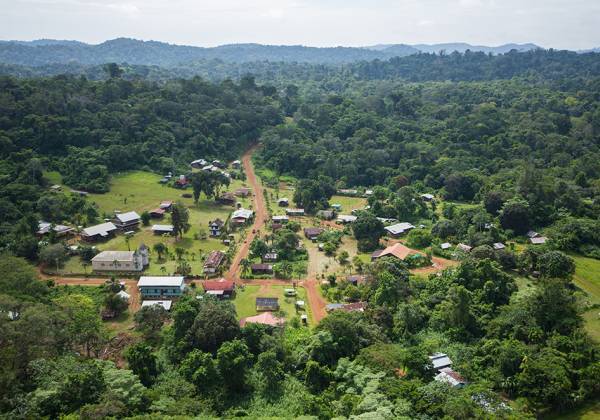Le Parc amazonien de Guyane, frontalier du Brésil, constitue l’un des plus grands espaces protégés au monde : 3,4 millions d’hectares, soit 40% de la Guyane française !
Délimité́ par deux grands fleuves, l’Oyapock à l’est, et le Maroni à l’ouest, il abrite l’une des zones les plus riches de la planète en termes de biodiversité́.
Cette richesse en fait un terrain de découverte exceptionnelle tant sur le plan de la flore, de la faune que des cultures indigènes.

Territoire d'exception
La forêt du sud de la Guyane abrite les espèces emblématiques amazoniennes : jaguars, primates, loutres géantes, tapirs, caïmans, anacondas, dendrobates colorés, coléoptères géants, papillons morpho aux couleurs métalliques... Concernant la flore, la nature a tous les droits au cœur du Parc amazonien. Arbres géants (plus de 50 m), lianes vertigineuses, plantes aux inflorescences spectaculaires peuplent la forêt amazonienne !
Pour le visiteur épris de culture, séjourner au cœur du Parc amazonien permet d’aller à la rencontre de populations porteuses d’identités culturelles fortes et en interaction permanente avec le milieu naturel qui les entourent. Amérindiens Wayana, Wayãpi et Teko, mais aussi Aluku, Noirs marrons du Maroni et Créoles vivent sur ce territoire depuis des générations au croisement des influences venues d’Amérique du Sud, des Caraïbes, d’Afrique, d’Asie et d’Europe.
Un voyage inoubliable
Une immersion dans le Parc amazonien de Guyane transforme le voyageur, interroge sa vision du monde et enrichit sa personnalité !
Unique experiences
Rencontre avec l'Esprit parc national - Guyane
Gardiens du terroir et de la nature, les professionnels Esprit parc national - Guyane sont des passionnés. Ils jouent un rôle essentiel dans la préservation et la valorisation de ce territoire d’exception.
Qu’il s’agisse de producteurs ou d’hébergeurs, chacun d’eux incarne les valeurs fondamentales de la marque : authenticité, respect de l’environnement, partage et engagement.
Explorez la sélection complète des saveurs du Parc amazonien de Guyane
